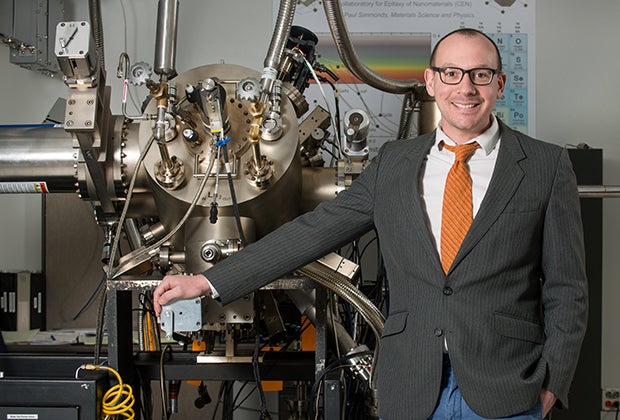Uranium, plutonium, thorium: these elements found in the bottom row of the periodic table of elements (known as actinides) make up the backbone of current nuclear reactor power production. According to the World Nuclear Association, nuclear power produced 20% of U.S. electricity in 2019.
But while these materials are critical for nuclear energy generation, they are also expected to have exotic properties driven by the unique arrangement of electrons in these atoms. Uranium and other actinides contain electrons that occupy what is known as the 5f shell (the element’s outermost shell). The challenge, however, is that fundamental studies of how electrons and other particles move in these 5f materials have been limited by the fact that high quality crystalline samples are unavailable. Crystal defects and impurities in the final product scatter these particles, making it almost impossible to study their basic properties.
To address this problem, Boise State associate professor Paul Simmonds and collaborators at Idaho National Laboratory (INL) have an idea that could help advance the fundamental science of nuclear materials. By using a process called molecular beam epitaxy, the team intends to ‘grow’ highly pure nuclear materials with almost perfect crystallinity to empower researchers to study their basic physical properties.
“Currently these materials are used for nuclear fuels,” Simmonds said. “However, if we can grow these materials with few defects using MBE then for the first time we will be able to study their thermal and electronic properties in full detail. As a result, we hope to observe some exotic quantum mechanical properties that have been predicted for these materials but which are typically hard to measure due to the large numbers of defects present.”
The team’s concept, which can be read here, was published in Nature Communications on April 25, 2022.

Molecular Beam Epitaxy (MBE)
Inside the MBE system, beams of atoms are gradually layered onto a surface where they land and bond in planned structures. The final product contains only the desired elements arranged in the desired structure. This allows researchers to form nanomaterials like quantum dots, or layers of different materials, known as heterostructures, with atomic precision. In short, MBE empowers researchers to grow ‘perfect’ materials. This method has existed since the 1970s, but the team’s goal to grow actinide materials using the process is novel.
“When people study the thermal properties of these imperfect nuclear materials, grains and other defects inside them obscure the fundamental ways that particles such as electrons and phonons, which are basically ‘quantum heat particles’ move,” Simmonds said. “Using MBE we intend to grow these materials as single crystals with few defects. We will then be able to observe the movement of the electrons and phonons with unprecedented accuracy.”
Using their new MBE system, INL researchers will begin testing their hypothesis. They will investigate whether it is possible to grow single crystal actinide materials using MBE that have very low defects, and which exhibit new and potentially useful properties.
“For the first time we will see the underlying behavior of the electrons and phonons as they move through these ‘clean’ materials,” Simmonds said. “Not only will this allow us to measure the electronic and thermal properties of the materials with precision, we also hope to observe the unusual quantum mechanical effects that arise from the presence of 5f electrons in actinide atoms like uranium.”
“This new and unique synthesis capability will not only help our nuclear programs but will also increase our efforts to stimulate more fundamental research on actinide materials at the laboratory,” said Krzysztof Gofryk, INL physicist and lead for their Center for Quantum Actinide Science and Technology.
About Idaho National Laboratory
Battelle Energy Alliance manages INL for the U.S. Department of Energy’s Office of Nuclear Energy. INL is the nation’s center for nuclear energy research and development, and also performs research in each of DOE’s strategic goal areas: energy, national security, science and the environment. For more information, visit www.inl.gov. Follow us on social media: Twitter, Facebook, Instagram and LinkedIn.